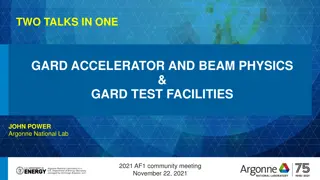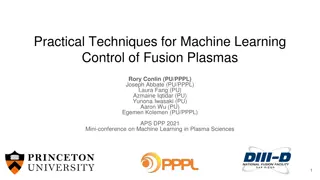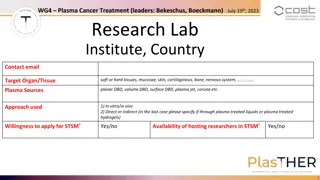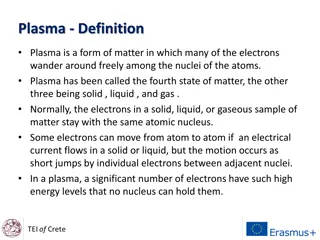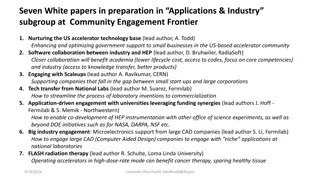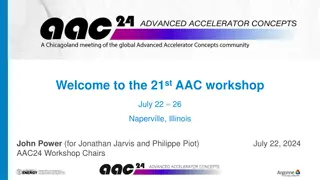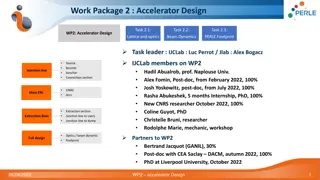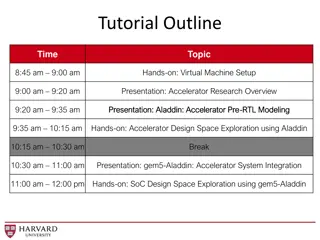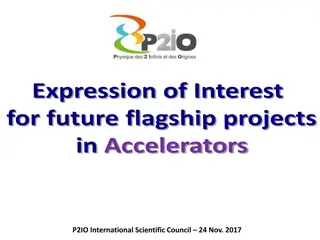European Plasma Research Accelerator with Excellence in Applications
The European Plasma Research Accelerator project, also known as EuPRAXIA, is a cutting-edge initiative that aims to develop a laser driver for advanced accelerator concepts. Led by a team of experts from various European countries, the project focuses on laser requirements, overall layout, thermal management options, modeling, pump lasers, and more. With funding from the European Union's Horizon 2020 program, EuPRAXIA is set to drive innovation in plasma research and accelerator technology.
- European Plasma Research Accelerator
- EuPRAXIA project
- Laser requirements
- Horizon 2020 funding
- Advanced accelerator concepts
Download Presentation

Please find below an Image/Link to download the presentation.
The content on the website is provided AS IS for your information and personal use only. It may not be sold, licensed, or shared on other websites without obtaining consent from the author. Download presentation by click this link. If you encounter any issues during the download, it is possible that the publisher has removed the file from their server.
E N D
Presentation Transcript
EUROPEAN PLASMA RESEARCH ACCELERATOR WITH EXCELLENCE IN APPLICATIONS ESFRI ESFRI 2021 6th European Advanced Accelerator Concepts Workshop 17 23 Sept 2023 Hotel Hermitage, La Biodola Bay, Isola d'Elba, Italy ESFRI EuPRAXIA laser requirements and current conceptual design issues Leonida Antonio GIZZI (CNR, Pisa, Italy) with Paul CRUMP, (FBH, Germany) Luca LABATE, (CNR, Pisa, Italy) Guido TOCI (CNR, Firenze, Italy) http://eupraxia-project.eu This project has received funding from the European Union s Horizon 2020 research and innovation programme under grant agreement No 653782. 1
Outline ESFRI ESFRI 2021 EuPRAXIA laser requirements Overall layout Thermal management options Modelling Pump lasers Summary 2
The EuPRAXIA Project ESFRI ESFRI 2021 With the inclusion in ESFRI and the approval of the Preparatory Phase Project, EuPRAXIA must rapidly move from the conceptual design to a viable technical design of the laser driver. R. W. Assmann, M. K. Weikum, T. Akhter, D. Alesini, A. S. Alexandrova, M. P. Anania, N. E. Andreev, I. Andriyash, M. Artioli, A. Aschikhin, T. Audet, A. Bacci, I. F. Barna, S. Bartocci, A. Bayramian, A. Beaton, A. Beck, M. Bellaveglia, A. Beluze, A. Bernhard, A. Biagioni, S. Bielawski, F. G. Bisesto, A. Bonatto, L. Boulton, F. Brandi, R. Brinkmann, F. Briquez, F. Brottier, E. Br ndermann, M. B scher, B. Buonomo, M. H. Bussmann, G. Bussolino, P. Campana, S. Cantarella, K. Cassou, A. Chanc , M. Chen, E. Chiadroni, A. Cianchi, F. Cioeta, J. A. Clarke, J. M. Cole, G. Costa, M. -E. Couprie, J. Cowley, M. Croia, B. Cros, P. A. Crump, R. D Arcy, G. Dattoli, A. Del Dotto, N. Delerue, M. Del Franco, P. Delinikolas, S. De Nicola, J. M. Dias, D. Di Giovenale, M. Diomede, E. Di Pasquale, G. Di Pirro, G. Di Raddo, U. Dorda, A. C. Erlandson, K. Ertel, A. Esposito, F. Falcoz, A. Falone, R. Fedele, A. Ferran Pousa, M. Ferrario, F. Filippi, J. Fils, G. Fiore, R. Fiorito, R. A. Fonseca, G. Franzini, M. Galimberti, A. Gallo, T. C. Galvin, A. Ghaith, A. Ghigo, D. Giove, A. Giribono, L. A. Gizzi, F. J. Gr ner, A. F. Habib, C. Haefner, T. Heinemann, A. Helm, B. Hidding, B. J. Holzer, S. M. Hooker, T. Hosokai, M. H bner, M. Ibison, S. Incremona, A. Irman, F. Iungo, F. J. Jafarinia, O. Jakobsson, D. A. Jaroszynski, S. Jaster-Merz, C. Joshi, M. Kaluza, M. Kando, O. S. Karger, S. Karsch, E. Khazanov, D. Khikhlukha, M. Kirchen, G. Kirwan, C. Kit gi, A. Knetsch, D. Kocon, P. Koester, O. S. Kononenko, G. Korn, I. Kostyukov, K. O. Kruchinin, L. Labate, C. Le Blanc, C. Lechner, P. Lee, W. Leemans, A. Lehrach, X. Li, Y. Li, V. Libov, A. Lifschitz, C. A. Lindstr m, V. Litvinenko, W. Lu, O. Lundh, A. R. Maier, V. Malka, G. G. Manahan, S. P. D. Mangles, A. Marcelli, B. Marchetti, O. Marcouill , A. Marocchino, F. Marteau, A. Martinez de la Ossa, J. L. Martins, P. D. Mason, F. Massimo, F. Mathieu, G. Maynard, Z. Mazzotta, S. Mironov, A. Y. Molodozhentsev, S. Morante, A. Mosnier, A. Mostacci, A. -S. M ller, C. D. Murphy, Z. Najmudin, P. A. P. Nghiem, F. Nguyen, P. Niknejadi, A. Nutter, J. Osterhoff, D. Oumbarek Espinos, J. -L. Paillard, D. N. Papadopoulos, B. Patrizi, R. Pattathil, L. Pellegrino, A. Petralia, V. Petrillo, L. Piersanti, M. A. Pocsai, K. Poder, R. Pompili, L. Pribyl, D. Pugacheva, B. A. Reagan, J. Resta-Lopez, R. Ricci, S. Romeo, M. Rossetti Conti, A. R. Rossi, R. Rossmanith, U. Rotundo, E. Roussel, L. Sabbatini, P. Santangelo, G. Sarri, L. Schaper, P. Scherkl, U. Schramm, C. B. Schroeder, J. Scifo, L. Serafini, G. Sharma, Z. M. Sheng, V. Shpakov, C. W. Siders, L. O. Silva, T. Silva, C. Simon, C. Simon-Boisson, U. Sinha, E. Sistrunk, A. Specka, T. M. Spinka, A. Stecchi, A. Stella, F. Stellato, M. J. V. Streeter, A. Sutherland, E. N. Svystun, D. Symes, C. Szwaj, G. E. Tauscher, D. Terzani, G. Toci, P. Tomassini, R. Torres, D. Ullmann, C. Vaccarezza, M. Vall au, M. Vannini, A. Vannozzi, S. Vescovi, J. M. Vieira, F. Villa, C. -G. Wahlstr m, R. Walczak, P. A. Walker, K. Wang, A. Welsch, C. P. Welsch, S. M. Weng, S. M. Wiggins, J. Wolfenden, G. Xia, M. Yabashi, H. Zhang, Y. Zhao, J. Zhu & A. Zigler EuPRAXIA Conceptual Design Report The European Physical Journal Special Topics 229, 3675 4284 (2020); https://doi.org/10.1140/epjst/e2020-000127-8 3
The EuPRAXIA project ESFRI ESFRI 2021 The EuPRAXIA project aims at the construction of an innovative compact electron accelerator using laser- and electron-beam-driven plasma wakefield acceleration; EuPRAXIA foresees the implementation of a laser wakefield accelerator (LWFA) at the 1-5 GeV target energy and a repetition rate of 20-100 Hz, requiring the most advanced and robust ultrashort pulse laser technologies available to date; The Design Study project was carried out initially by 16 laboratories and universities from 5 EU member states within the European Union s Horizon 2020 programme; A Conceptual Design Study has addressed the development of a ultrashort pulse laser system (pulse durations in the range of tens of fs) and energies up to 100 joules, yielding a PW scale peak power, targeting a repetition rate of up to 100 Hz, a performance never achieved so far EuPRAXIA was included in the ESFRI Roadmap (2021) and a Preparatory Phase project is ongoing. 4
The EuPRAXIA project: main specs ESFRI ESFRI 2021 5
RATIONALE OF LASER DRIVER DESIGN STUDY ESFRI ESFRI 2021 In the EuPRAXIA project, several alternative technological approaches were considered and down- selected, to provide the required laser driver performances. We based the design on Chirped Pulse Amplification (CPA) in Ti:Sapphire, pumped by all-solid state green lasers (i.e. diode pumped, frequency doubled Yb or Nd lasers) Thermal management related to the handling of high pump average power was the most complex aspect in the design, requiring out-of-the-box thinking and original solutions Optimization of energy extraction was also an issue, aimed to reduce pump energy requirements and waste heat production. Three laser systems envisaged, to drive three stages: - Laser Plasma Injector at 150 MeV (LPI 150MeV) - Laser Plasma Injector/Accelerator at 1 GeV (LPI 1GeV) - Laser Plasma Accelerator at 5 GeV (LPA 5GeV) For each system, two levels of performances considered: P0: low energy, 20 Hz rep rate P1: high energy, 100 Hz rep rate 6
GENERAL ARCHITECTURE ESFRI ESFRI 2021 Laser 1 Laser 1 Modularity of amplification stages: Laser 1 Laser 2 Laser 2 LPI 150 MeV LPI 1 GeV LPA 5 GeV Laser1 Laser1 + Laser2 Laser1 + Laser2 + Laser3 Laser 3 adjustmentson pulse duration/bandwidth Synchronization: common master oscillator Pulse duration/wavelengthtailoring: separate front end Scalability: possibilityto upgrade from P0 to P1 performance levels withouta major changes LPI 150 MeV LPA 5 GeV LPI 1 GeV 7
Underpinning EuPRAXIA Laser development ESFRI ESFRI 2021 High repetition rate (100 Hz) will speed up R&D of pending issues for Ti:Sa laser TDR DIODE LASERS EFFICIENCY, BRIGHTNESS AND LIFETIME COMPRESSOR AND TRANSPORT: THERMAL AND MECHANICAL STABILITY AMPLIFIER GEOMETRY TRANSMISSION VS. REFLECTION DPSSL PUMP SOURCES TECHNOLOGY THERMAL MANAGEMENT OF POWER AMPLIFIERS Multipass transmission Gold -> MD, MLD, MMLD reduction of the thermal load cooling of residual heat control of thermal effects DiPOLE100 (STCF) Multipass reflection WATER/GAS COOLING P-60 technology(Amplitude) Currently no solution for full system specs (P1): development Main challenges: large optics, mechanical stability, beam quality control, pointing stability Needs development Prototyping needed Prototyping needed 8
Transport to target ESFRI ESFRI 2021 Main challenges: large optics, mechanical stability, cooling of gratings, beam quality control a) b) deformable mirror deformable amplifier mirror last OAP OAP filter 45 filter achromatic lens achromatic lens last amplifier 9
Compressor: grating technology ESFRI ESFRI 2021 Different technologies under evaluation to address main issues with higher repetition rate. Strategy includes reduction of the thermal load at high average power, cooling of residual heat and control of thermal effects on compression quality. 10
Beam Pointing Stability ESFRI ESFRI 2021 Eupraxia requirements for beam pointing stability are extremely demanding. Both passive and active control will be required. Prior to the implementation of control strategies, tools are being developed to measure pointing stability performances at EuPRAXIA facilities and labs. 0,1 rad 1 rad 50 nrad Laser angular fluctuations footprints at 150 Hz Environmental angular noise of about 30 nano-rad up to the MHz We already detect <100nrad fluctuations Z. Mazzotta, F. Mathieu in collaboration with S. Cialdi, D. Cipriani, S. Capra of Universit degli studi di Milano. regime and more 64 ~40nrad 48 ~10nrad Angular fluctuation (nrad) 32 16 Spectral analysis of the laser fluctuation. 500 0 300 400 200 100 Frequency (Hz) 11
AMPLIFICATION CHAIN: REQUIREMENTS ESFRI ESFRI 2021 LASER 1 - Injector 150 MeV LASER 2 - Injector 1 GeV Parameter Label 1 (nm) Etarget Eout dE Etot 1 f1 <E> P0 800 5 8.8 7 7 30 20 1 P1 800 7 12.5 5 10 20 100 0.6 Parameter Label 2 (nm) Etarget Eout dE 2 f2 <E> P0 800 15 18.8 7 30 20 1 P1 800 30 37.5 5 20 100 0.6 Wavelength (nm) Maximum energy on target (J) Maximum output energy (J) Energy tuning resolution (% of targeted value) Total output energy (incl. Diagnostic beams) Pulse length (FWHM) (fs) Repetition rate (Hz) Requirement on energy stability (RMS) % Wavelength (nm) Maximum energy on target (J) Maximum output energy (J) Energy tuning resolution (% of targeted value) Shortest pulse length (FWHM) (fs) Repetition rate (Hz) Requirement on energy stability (RMS) % LASER 3 - Driver 5 GeV Parameter Label 2 (nm) Etarget Eout dE 2 f2 <E> P0 800 50 62.5 7 60 20 1 P1 800 100 125 5 50 100 0.6 Wavelength (nm) Maximum energy on target (J) * Maximum output energy (J) Energy tuning resolution (% of targeted value) Shortest pulse length (FWHM) (fs) Repetition rate (Hz) Requirement on energy stability (RMS) % Maximum output energy: (Energy on Target)/(Compressor Efficiency) Compressor efficiency assumed 80% Seed energy: 1.5 J 12
AMPLIFIERS MODULAR ARCHITECTURE ESFRI ESFRI 2021 Foreseen I/O energy and pump requirements LPI 150 MeV From the front end To the compressor LASER1 Eout8.8 J (P0) / 12.5 J (P1) Epump: 19.2J (P0)/ 25.7 J (P1) LPI 1GeV From the front end To the compressor LASER2 LASER1 Eout18.8 J (P0) / 37.5 J (P1) Eout8.8 J (P0) / 12.5 J (P1 Epump: 37.2J (P0)/ 65.2 J (P1) LPA 5GeV From the front end LASER1 LASER2 To the compressor LASER3 Eout8.8 J (P0) / 12.5 J (P1) Eout18.8 J (P0) / 37.5 J (P1) Eout62.5 J (P0) / 125 J (P1) Epump: 105J (P0)/ 197 J (P1) Three main modules: LASER1, LASER2, LASER3 LASER1: stand-alone forLPI 150 MeV LASER2: output stage forLPI 1 GeV, secondstage forLPA 5GeV LASER3: high energy stage forLPA 5GeV Two levels of performance : P0 and P1 13
THERMAL MANAGEMENT ESFRI ESFRI 2021 Expanding knowledge base for water cooled with "through" propagation: some examples Water cooled Ti:Sa amplifier ( Active Mirror configuration) under development at ELI-HU (After V. Cvhykov et al. , Opt. Lett, 41, 3017, 2016) Fluid (D2O ) cooled 3 kW Nd:YAG laser, 20 kW CW pump power, D2O (After X. Fu et al. , Opt. Express, 22, 18421 (2014) Fluid (Siloxane ) cooled Nd:YLF laser, 5 kW CW pump power (After Z. Ye et al. , Opt. Express, 24, 1758 (2016) 14
AMPLIFICATION MODULES: CONCEPTUAL LAYOUT ESFRI ESFRI 2021 Two possible solutions envisaged, determined by thermal management considerations Common features: - gas cooling found to be insufficientat the given power density - face cooling of gain elements by water flow (longitudinal cooling) - gain volume split in some sub-elements to increase cooling surface - multi-steppumping for parasitic laser management 1 Multipass amplificationscheme in transmission Input beam Water flow Steering mirror Ti:Sapphire crystals Pump beam Steering mirror Ouput beam Window Window Pump recycling mirror Water flow Pump recycling mirror Water flow Steering mirror Steering mirror Double side, double pass pumping Crystal split in 2 elements, face cooled by water flow, to increase cooling surface Multipass amplification (4 to 6 depending on stages) Absorption layer on crystal sides for parasitic lasing suppression 15
AMPLIFICATION MODULES: CONCEPTUAL LAYOUT ESFRI ESFRI 2021 Two possible solutions envisaged, determined by thermal management considerations Common features: - face cooling of gain elements by water flow (longitudinal coling) - gain volume split in some sub-elements to increase cooling surface - multi-step pumping for parasitic laser management 2 Multipass amplification scheme in reflection ( Active mirror ) Ouput beam Input beam Multipass mirrors Pump recycling mirrors Pump beam Absorber Ti:Sapphire crystal Cooling flow Cooling flow Reflective coating (cooled side) Ti:Sapphire crystals Multi-pass pumping scheme to ensure effective pump absorption Overall pump energy equally divided among the 4 elements Overall gain length split in 4 elements, water cooled on the back side Multiple reflections required to obtain efficient energy extraction Absorption layer on crystal sides for parasitic lasing suppression 16
CRITICAL DESIGN CROSSROAD ESFRI ESFRI 2021 Which geometry is better? Multipass reflection Multipass transmission Ouput beam Input beam Input beam Water flow Pump recycling mirrors Steering mirror Ti:Sapphire crystals Pump beam Pump beam Steering mirror Absorber Ouput beam Ti:Sapphire crystal Window Window Pump recycling mirror Coolingflow Water flow Pump recycling mirror Coolingflow Water flow Steering mirror Steering mirror Reflective coating (cooledside) Pro s Pro s - Simpler scheme (up to 2 sub-crystals, single pump path) - Broadercooling surface available - Less sensitive to mechanical vibrations - Less sensitive to parasitic reflections (contrast issues) - No aberration from cooling fluid - Modularity Con s - Less cooling capability - More complex set-up (up to 3 units required, pump splitting) - More sensitive to mechanical vibrations - Possible issues from parasitic reflections (pulse contrast) Con s - Aberrations from fluid turbulences - Very critical design of the fluid ducts Both schemes equally studied in the preliminary design: equivalentperfomances from simulations Critical aspects (i.e. optical aberrations from cooling fluid) beyond numerical simulations capabilities Dedicated experimentaldevelopment (i.e. realization and testing of small scale pilot devices) is required to address this design choice 17
EXAMPLE OF LAYOUT FOR TRANSMISSION AMPLIFIERS ESFRI ESFRI 2021 y Amplificationpath 6 passes configuration, bow-tie geometry Angle between passes Footprint length: x z ~ n x 1.2 (n=1,2,3) ~ 4 mt (Laser 1) ~ 5 mt (Laser 2) ~ 8 mt (Laser 3) Ti:Sa (to avoidbeam superimposition) Pumping path (single pump source, split in 2 pulses) y First pulse Each pump pulses passes twice through the crystals Pumping from both sides to reduce peak fluence and parasitic lasing x z Extraction During Puming (EDP) implementation The pump pulse must be split before of the injection; one of the pulses goes through a delay line to implementthe EDP Ti:Sa Second pulse (froma delay line) Off-plane angular multiplexing of the pump beams to have more pump gates available z x y Pump angular multiplexing: 2 pumping gates required foreach pump laser 18
PUMP TIMING AND EDP ENERGY RIPARTITION ESFRI ESFRI 2021 Seed pulse Seed pulse (at t=0) Amplified pulse 1 Pump pulse Second pump pulse (after delay line) First pump pulse 2 Pump pulse Stored energy tr 5tr 2tr 4tr 3tr 0 t Pump pulse absorption time ~10 ns tr: pulse round trip time between passes (12 ns, 15 ns, 18 ns respectively for Laser 1, Laser2 and Laser3 The delay line of the second pump pulse has to to provide the proper delay between the two pulses. 19
EXAMPLE OF LAYOUT FOR REFLECTION AMPLIFIERS ESFRI ESFRI 2021 y Amplificationpath 3 disks, 2 double passes configuration Half angle between passes Footprint length: x z ~ 1.2 -2.4 ~ 3 mt (Laser 1) ~ 5 mt (Laser 2) ~ 8 mt (Laser 3) Ti:Sa Ti:Sa (to avoidbeam superimposition) Footprint width < 1.5 m Ti:Sa Straightforwardextension to 4 disks Mirror Delay line Pumping path (single pump source) Pump pulse energy is distributed among the disks by beamsplitters (or waveplates+polarizers) Each pump pulse passes twice through the crystals y x Beamsplitter z Delay line EDP implementation The arrivalof the pump pulse is synchronized with the arrivalof the amplified pulse by means of fixed delay lines (equalpath length) . Energy repartitionbetween the passes is achieved by fine tuning of the delay Beamsplitter Delay line Off-plane pump injection to avoid beam path occlusions One injection gate for each pump source z x y 20
PUMP TIMING AND EDP ENERGY RIPARTITION ESFRI ESFRI 2021 Seed pulse (at t=0) Seed pulse f1 f2 Disk 1 Pump pulse t Stored energy 0 6tr Disk 2 f1 f2 tr t 5tr 0 Disk 3 f1 f2 2tr t 4tr 0 tr: pulse round trip time between passes (12 ns, 15 ns, 18 ns respectively for Laser 1, Laser2 and Laser3 The delay lines of the pump between the disk ensures synchronization of pump arrival with the seed pulse. Fraction f1of pump pulse energy is available for 1 pass amplification, fraction f2for the 2 pass. The ratio f1/f2can be adjusted by finely tuning the delay between the pump and the seed pulse 21
NUMERICAL SIMULATION OF AMPLIFICATION MODULES ESFRI ESFRI 2021 The amplification stages were numerically simulated (MIRO - CEA) The code allows for the simulation of amplification of ultrashort pulses, accounting for GVD, nonlinear effects, spectral narrowing effects and so on The different amplification stages were extensively analyzed in the different architectures (transmission vs reflection scheme) Simulations for the two architectures implemented: - same overall gain length, number of passes - same doping level - same overall pump energy - same beam cross section vs. We obtained: - Very similar energy extraction performance for the two schemes - Very similar sensitivity of output energy vs seed, pump energy Results are summarized in the following slides 22
AMPLIFICATION MODULES: AMP 1 ESFRI ESFRI 2021 Crystal clear aperture (cm) Doping level (%Wt.) 6 cm 0.075 Crystal thickness (cm, overall) Absorption coefficient (cm-1) 1.2 1.2 Performance level P0 Pump energy (J) 19.2 Pump beam diameter (cm, FWHM) 5.0 Pump fluence at crystal surfaces (J/cm2) 0.76 Absorbed pump energy (%) 94% Seed pulse energy (J) 1.5 Seed beam diameter (cm, FWHM) 4.7 Output energy Output beam diameter (cm FWHM) 8.9 4.5 Extraction efficiency Output beam peak fluence (J/cm2) 38.7% 0.55 15 (before the 4th pass) 2.4 EDP scheme 65% 1st pass, 35% 4th pass 0.53 Max GT Spump ( Eout/ Epump) Sseed( Eout/ Eseed) Performance level P1 Pump energy (J) 25.7 Pump beam diameter (cm, FWHM) 5.0 Pump fluence at crystal surfaces (J/cm2) 1.01 Absorbed pump energy (%) 94% Seed pulse energy (J) 1.5 Seed beam diameter (cm, FWHM) 4.7 Output energy (J) 12.7 Extraction efficiency 43.6% Output beam peak fluence (J/cm2) Output beam diameter (cm FWHM) 4.6 0.765 30 (before the 4th pass) EDP scheme 65% 1st pass, 35% 4th pass Max GT Spump( Eout/ Epump) 0.58 Sseed( Eout/ Eseed) 2.67 6 passes amplificationscheme 23
AMPLIFICATION MODULES: AMP 2 ESFRI ESFRI 2021 Crystal clear aperture (cm) 10 Crystal thickness (cm, overall) 2.0 Doping level (%Wt.) 0.05 Absorption coefficient (cm-1) 0.79 Performance level P0 Pump energy (J) Pump fluence at crystal surfaces (J/cm2) Seed pulse energy (J) Output energy (J) Output beam diameter (cm FWHM) EDP scheme 37.2 0.425 6.25 19.1 8.0 60% 1st pass, 40% 3rd pass 0.45 Pump beam diameter (cm, FWHM) Absorbed pump energy (%) Seed beam diameter (cm, FWHM) Extraction efficiency Output beam peak fluence (J/cm2) Max GT 9.0 96% 8.0 35.0% 0.38 6 (before the 3rd pass) 1.8 Spump( Eout/ Epump) Sseed( Eout/ Eseed) Performance level P1 Pump energy (J) Pump fluence at crystal surfaces (J/cm2) Seed pulse energy (J) Output energy (J) Output beam diameter (cm FWHM) EDP scheme 65.2 0.75 8.75 37.5 8.3 60% 1st pass, 40% 3rd pass 0.53 Pump beam diameter (cm, FWHM) Absorbed pump energy (%) Seed beam diameter (cm, FWHM) Extraction efficiency Output beam peak fluence (J/cm2) Max GT 9.0 96% 8.0 44.1% 0.72 14 (before the 3rd pass) 1.49 Spump( Eout/ Epump) Sseed( Eout/ Eseed) 6 passes amplificationscheme 24
AMPLIFICATION MODULES: AMP 3 ESFRI ESFRI 2021 Crystal clear aperture (cm) Doping level (%Wt.) 16 cm 0.03 Crystal thickness (cm, overall) Absorption coefficient (cm-1) 3.2 0.47 Performance level P0 (6 passes) Pump energy (J) Pump fluence at crystal surfaces (J/cm2) Seed pulse energy (J) Output energy (J) Output beam diameter (cm FWHM) EDP scheme 105 0.51 18.8 62.4 12.8 65% 1st pass, 35% 3rd pass 0.53 Pump beam diameter (cm, FWHM) Absorbed pump energy (%) Seed beam diameter (cm, FWHM) Extraction efficiency Output beam peak fluence (J/cm2) Max GT 14.0 96% 12.8 41.5% 0.49 18 (before the 1st pass) 1.64 Spump( Eout/ Epump) Sseed ( Eout/ Eseed) Performance level P1 (4 passes) Pump energy (J) Pump fluence at crystal surfaces (J/cm2) Seed pulse energy (J) Output energy (J) Output beam diameter (cm FWHM) EDP scheme 197 0.95 37.5 126.0 13.0 65% 1st pass, 35% 3rd pass 0.54 Pump beam diameter (cm, FWHM) Absorbed pump energy Seed beam diameter (cm, FWHM) Extraction efficiency Output beam peak fluence (J/cm2) Max GT 14.0 96% 12.8 44.9% 1.08 20 (before the 3rd pass) 1.4 Spump( Eout/ Epump) Sseed( Eout/ Eseed) 25
EXAMPLES OF SIMULATION RESULTS ESFRI ESFRI 2021 Input/output spectrum(AMP3, P1) Input/output beam profile(AMP3, P1) 12000 3500 1.2 Output fluence Input spectrum 10000 Input fluence 3000 1 Output spectrum Output fluence (J/m2) Input fluence (J/m2) 2500 8000 Intensity (a.u.) 0.8 2000 6000 0.6 1500 4000 0.4 1000 0.2 2000 500 0 0 0 -0.1 -0.05 0 0.05 0.1 760 780 800 820 840 Distance from axis (m) Wavelength (nm) Output energy vs. numberof passes (AMP3, P1, transmission / reflection schemes) Output energy vs. pump pulse energy (AMP1, P0) 135 11 125 Reflection scheme 115 Output pulse energy(J) 10 y = 0.5318x -1.267 Transmission scheme 105 9 95 Energy (J) 85 8 75 7 65 55 6 45 5 35 12 14 16 18 20 22 0 1 2 3 4 Pass # Pump pulse energy (J) 26
FLUID-DYNAMICS SIMULATIONS ESFRI ESFRI 2021 Water cooling of disk amplifiers: modelling physics - Simulation software: COMSOL multiphysics (ver. 4.2 and 5.2) - Finite Element Analysis approach - Numerical solution of the Navier-Stokes equations for mass and energy transport - Low Reynolds k- solution method - Thermal coupling with boundary layer at the channel walls (heated Ti:Sa crystal) - Time-averaged simulation (i.e. time-dependent turbulences not modelled) Example: - channel thickness 5 mm, flat channel walls - inlet flow speed 6 m/sec, - heat input 25 W/cm2(AMP3 at P1 performance level) - heated length 160 mm (AMP3 pump beam ); - temperature dependence of water properties - water input temperature 15 C - mesh 128000 elements Temperature distribution Velocity magnitude distribution 292 291 Water flow direction 290 289 288 Temperature of Ti:Sa surface at different inlet flow speed Water inlet temperature 15 C (288.15 K) Heat input 25 W/cm2, Channel heigth 5 mm Effective film coefficient (heat exchange coefficient between water and heated wall for different flow speed and heat input levels 27
THERMOMECHANICAL SIMULATIONS ESFRI ESFRI 2021 Temperature distribution Temperature distribution for AMP3 transmission disk (left, 1.6 cm thickness) and AMP3 reflection disk (right 1.3 cm thickness) at P1 pump level Modelling: Finite Element Analysis (FEA) Peak T: 89.5 C Peak T: 40.8 C Deformationdistribution Phase modification requires Adaptive Optics compensation Axial displacementdistribution (mm) for AMP3 transmission disk (left, 1.6 cm thickness) and AMP3 reflection disk (right 0.8 cm thickness) at P1 pump level Optical path difference(OPD) 2,50E+00 7,00E+00 OPD total (micron) OPD total (micron) 2,00E+00 6,00E+00 Parabolic fit Parabolic fit OPD in microns resulting from thermal expansion and thermooptic effect. Parabolic fit and higher order aberrationsalso shown. Left: AMP3 transmission disk; right AMP3 reflection disk at P1 pump level Difference Difference 5,00E+00 1,50E+00 4,00E+00 OPD (microns) OPD (microns) 1,00E+00 3,00E+00 2,00E+00 5,00E-01 1,00E+00 0,00E+00 0,00E+00 -100 -50 0 50 100 -100 -50 0 50 100 -5,00E-01 -1,00E+00 -2,00E+00 Distance from axis (mm) -1,00E+00 Distance from axis (mm) 28
PUMP SOURCES TECHNOLOGIES ESFRI ESFRI 2021 DiPOLE 100 (STCF) Cryogenically operated Yb:YAG, diode pumped 100J @1030 nm , 10 Hz demonstrated Energy stabilty 1% RMS (few hours of operation) 60 J SHG @ 515 nm, 10 Hz expected Possible upgrades include: - IR Output energy 150 J - SHG output > 100 J - PRF 100 Hz @ 10 J P-60 technology (Amplitude) Nd:YAG Disk Amplifier Heads (DAH), liquid cooled. Currentdesign: flashlamp pumping Scalable design (n. of DAH units): P20, P30 Design specificatons (6 DAH): ~80 J @ 1064 nm, 10 Hz 60 J @ 532 nm, 10 Hz Possible developments - Diode pumping - 50 Hz rep rate 29
DIMENSIONING OF PUMP SOURCES ARRAYS ESFRI ESFRI 2021 P0 performance level Issue: P0 operation regime has a pulse repetition rate of 20 Hz. The two available pump sources have a repetition rate of only 10 Hz. To circumvent this problem (until higher rep rate devices are developed) we considered to use two (or two sets) of pump sources and shot them interleaved, so that repetition rate of the pump pulses arriving to the amplifiers id effectively doubled. Issue: Pump energies higher than about 60 J (as needed by the AMP3 module) require more than a single pump source. This calls for specific arrangements to multiplex the input from several pump units to the amplification crystals. P1 performance level Issue: P1 operation regime considers a pulse repetition rate of 100 Hz, along with higher energies than P0. Currently no solutions for pump sources are available to meet these requirements. Speculatively, we have considered the availability of a system similar to Amplitude P60 but operating at 50 Hz (conversion to diode laser pumping of the flashlamp pumped P60) with the same output energy of 60 J/pulse in the green. Again, reaching 100 Hz requires the time interleaving of a pair of twin sources. This analysis did not include the DiPOLE 100 system, as no developments are currently planned toward a high energy, high rep rate system. 30
Diode laser developments ESFRI ESFRI 2021 31
MAIN OUTPUTS OF THE EUPRAXIA DESIGN STUDY ESFRI ESFRI 2021 Requirements on energy, pulse duration, stability etc set by the LPA working point Design based on CPA in Ti:Sapphire, dictated by requirements vs. time scale Thermal management issues addressed by means of liquid cooling Main developments required: Prototyping of Ti:Sa amplifiers: fluid cooling (choice between reflection/transmission amplifier): possibly by means of pilot devices Addressing 100 Hz pump lasers developments Thermal management of compressor gratings Stability (pointing & more) and active control Driver pulse temporal shaping and synchronization Construction Integration Issues 32
The end ESFRI ESFRI 2021 Thank you! 33







